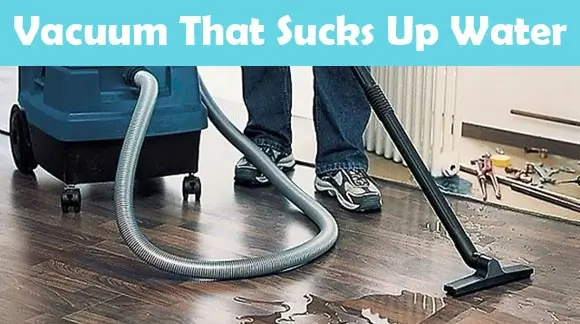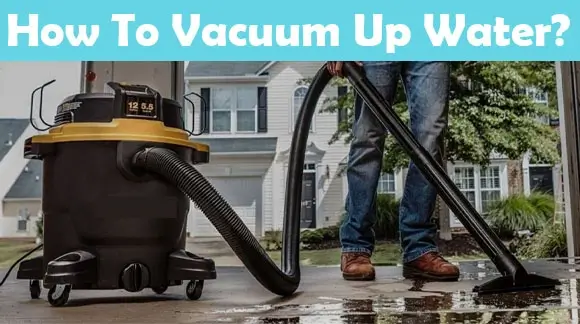There’s some water on your floor, and you want to dry it up, so you bring out your cleaning friend, a vacuum cleaner. However, you ask yourself, “since vacuums are electrical devices, is it safe to use them on water?” Well, I’ll start with the good news first. There are vacuums that sucks up water, you can find easily in the market.
However, they’re not like standard vacuum cleaners and contain unique qualities that an ordinary vacuum cleaner can’t possess. Therefore, using a typical upright vacuum cleaner on water may cause one of two things for you.
Either the water makes its way to the internal hardware of your vacuum cleaner, or you end up electrocuting yourself. I don’t mean to scare you, but this is the truth.
However, if you use vacuums built for sucking up water, such as a Shop Vac, you’re safe from these troubles, and you’ll also manage to dry up that water spilled on the floor. This thought might cross your mind that how to use shop vac for a dry pickup?
Shop Vacs aren’t any ordinary vacuum cleaners; they’re specifically built for industrial or commercial usage, containing a strong suction and a thick hose that enables them to suck up large debris from these areas. Generally, these vacuum cleaners aren’t meant to clean your household.
Don’t give up just yet, because Shop wet dry Vacs are also intended for household usage.
Shop Vacs or Wet/Dry vacuum, unlike an ordinary vacuum cleaner, doesn’t come with collections bags; however, they’re equipped with a set of two devices, each designed for water spills and dry debris.
If a Shop Vac’s motor noise is unbearable for you, I’ve got another good news! Like an industrial vacuum cleaner, canister vacuums are relatively quieter and get the water-sucking job done.
These vacuum cleaners are interconvertible, allowing them to change to a dry or wet vacuum, according to your preferences.
Can I Vacuum Up Water?
Electric currents have caused around 12 percent of the fatalities in various industrial sectors in the United States. You may be following if you attempt to dry up water spills from an ordinary vacuum cleaner.
Standard upright vacuum cleaners can’t suck up water; therefore, using it to do so will end up in hardware damage or electrocution.
However, other types of vacuum cleaners, such as Shop Vacs or Canister vacuums, are specifically designed to dry up water spills and efficiently drain them without causing damages or system failures.
How Vacuum Works that Sucks Up Water?
To compensate for the absence of collection bags, these vacuum cleaners contain two buckets, one used for dry stuff and in other vacuum sucks up water. Therefore, the liquid and dry content of these vacuum cleaners separate.
When the air has to pass from a congested area, the speed and suction increase, therefore, picking up dust particles and debris effectively. These particles then pass onto the collection chamber.
The particles release from the vacuum cleaner when the air passes through a vast collection chamber. The air goes to the top of the vacuum cleaner and vents out from there.
Shop Vacs or Canister vacuums contain two vital components, i.e., a collection and a motor unit, where the motor locates right above the collecting unit. The device’s fan dragged the air through the hose and the collecting team.
Shop Vacs and Canister vacuums also contain effective insulation, reducing the risk of electrocution. However, at the end of the day, they are electrical devices, and there is always a risk of electrical fatalities while dealing with them.
A safe way to tackle this issue is to plug these vacuum cleaners into GFCI power outlets. These further reduce the risk of electrocution and eliminate power usage in life-threatening situations.
Wet/dry vacs are an efficient source of sucking up water and other liquids. However, it’s only suitable for some kinds of beverages. For instance, where you can suck up juice spills from a wet-dry vac, you can’t use them in sucking up gasoline or other flammable liquids as they can easily make your vacuum cleaner blow up.
How to Use Vacuum that Sucks Up Water?
Shop Vacs make the process of sucking and drying up water easier. Follow the instructions below to use Wet/Dry Shop vac to vacuum up water.
Also Read: Can a vacuum cleaner clean tiles?
1. Bag Removal
Shop Vacs or other wet/dry vacuum cleaners never use a collecting unit when it comes to drying up water. Therefore, unhook the blower-unit section before proceeding, and remove your vacuum’s collection unit and other attachments.
2. Substitute Your Vacuum’s Filters or Remove Them
Filters typically used in dry operations are made of paper, and they sometimes act as filter cloths wrapped around your vacuum cleaner’s filter chamber through a rubber band.
Since the composition of these filters isn’t viable for wet operation, we suggest to remove them. However, if your vacuum cleaner comes with a damp filter, you can replace the dry filter with the wet filter to perform the wet operation.
3. Attachment of a Wet Nozzle
Your vacuum cleaner usually comes with a variety of nozzles. Each nozzle works best for a particular surface. In this case, the wet nozzle with your Shop Vac is the most efficient during damp operation. However, you can use other nozzles as well.
4. Plug Your Shop Vac into a GFCI Outlet
As mentioned earlier, GFCI outlets provide enhanced protection against possible electric shocks, so they are recommended for power usage in Shop Vacs.
However, since these vacuum cleaners contain double insulation, plugging your Shop Vac into a non-CGFI outlet isn’t all that bad.
5. Vacuum to Suck Up the Water
To suck up the water spills on the floor, hold the wet nozzle above the damp area and place it until all the water has dried up. After that, you can move your vacuum cleaner to a new damp location.
Follow the same steps regardless if the water is in excess; since canister or wet/dry vacuums are capable of sucking up a large quantity of water, they’ll be able to finish the job.
However, if your vacuum cleaner’s motor sound changes, then it means that the canister has filled up.
6. Removal of Extensions
Be sure to remove any unnecessary extensions connected to your vacuum cleaner, such as the extension wand, since they make the wet operation relatively harder.
7. Debris Removal and Disposal of Water
Once you complete the wet operation, open your vacuum’s bin compartment and remove any macro-sized debris that you find. Pour out the water into a disposal-designated area since debris-containing water harms plants.
8. Disinfection of Canister and Surrounding Areas
There are high chances of mold formation in your vacuum’s canister and surrounding areas after pouring out the water.
To stay clear of this, wash the canister with fresh water. Use ¼ cup of home-use chlorine bleach along with warm water. Then, clean out the canister properly, and run water through your vacuum cleaner’s hose.
After cleaning, hang the canister vertically and dry all the accessories adequately before reattaching them.
Conclusion
Ordinary vacuum cleaners can’t effectively dry up water spills. In fact, the water can damage the hardware of the vacuum cleaner or lead to electrocution. Instead, a special vacuum that sucks up water is known as Shop Vacs or Canister vacuum. They can dry up a large number of water spills and can also clear out dry debris.

Hi Everyone.
I’m Safeer. I always loved trying out the latest cleaning and home products and sharing my thoughts about those products with you awesome people. Whether it’s related to general cleaning or it includes cleaning with high-tech vacuum cleaners, I always test them myself and then share valuable opinions with you. Additionally, I also let you know how to resolve particular issues of vacuum cleaners. To look for detailed reviews and troubleshooting tips about vacuum cleaners VaccumCleanersMag is the perfect abode for you.

